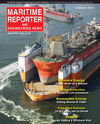
Page 28: of Maritime Reporter Magazine (September 2015)
Offshore Energy Technologies
Read this page in Pdf, Flash or Html5 edition of September 2015 Maritime Reporter Magazine
MARITIME SURVEILLANCE
Monitoring for Ef? ciency, Safety erry masters operating off the west ferry sailing decisions to be made in a coast of Scotland traditionally timely manner.
Fwould have to sail to a port and on “OTT installed the ? rst monitoring sta- arrival visually assess the weather and tion in August 2014 and the network is tide conditions before deciding whether now almost complete with sensors pro- it was safe to berth alongside the pier or viding data every 1 minute via UHF radio quayside: a process which wasted time to ‘gateways’ in the ferry of? ces, which and fuel, and frustrating the paying pas- then submit the data via the internet to sengers. The berthing of ferries is a a central server, which can be remotely high skill job, particularly during bad accessed by authorized users,” said Da- weather, and the decision on whether a vid McHardie, CMAL Harbor Master. speci? c ferry can safely berth at a spe- “We have a regulatory requirement to ci? c port is subjective and ultimately can monitor the tide level in our statutory only be taken by the ferry Master, and harbors, but this system also provides includes considerations of not only those essential weather information for our onboard, but shoreside personnel aiding ports. In the past, these measurements with mooring operations. were taken manually, so the availability
With multiple sites in island locations, of continuous multiparameter data is an remote access to accurate local data pro- enormous improvement – not just in the viding live information on tide level and quality and value of the information, but key climatic conditions could facilitate also in the safety bene? ts for harbor op- substantial improvements to the service erations staff, that this provides.” by aiding the Masters to make a more in- for example, since the monitoring net- Each monitor is located adjacent to formed decision at an earlier stage in the Live Data voyage – in some instances even before The availability of live data on port work was installed, we have recorded the main berthing area on the pier with departing the previous port or harbor. conditions theoretically enables the a sudden drop in temperature of 8°C in a lockable GRP control box. The system
Caledonian Maritime Assets Limited ferry Masters to make better informed just 5 minutes at the port of Armadale on is comprised of: an OTT radar level sen- (CMAL), which owns many of the fer- decisions at an earlier stage, potentially the Isle of Skye, and a maximum wind sor; a Lüfft ultrasonic weather monitor gust of 96 knots at Castlebay on the Isle measuring wind speed, gust and direc- ries, ports and harbors in the region, pro- saving time, fuel and costs. Emphasiz- of Barra. These conditions represent a tion, air temperature and barometric cured a network of 15 tide and weather ing the growing need for data, McHardie stations from OTT Hydrometry. The said: “In recent years, severe weather rapid deterioration of conditions and the pressure; an Adcon radio unit with back- monitoring network enables us to re- up batteries and a marine grade antenna. new monitoring equipment provides events appear to have become more fre- live data on port conditions to enable the quent and they seem to develop faster; spond quickly and effectively.” The radar tide level sensor is an OTT
GOST Marine Security Video Recording Device
GOST (Global Ocean Security Technologies) released its next generation security video solution, the GOST Watch HD Internet Video Recorder (IVR). The new video recording system features a four terabyte hard drive – designed to capture and store video on a modern yacht – that is capable of continuously recording and storing 90 days of video from up to six cameras. The GOST Watch
HD IVR system supports the highest resolution video recording from any GOST or third party analog cameras connected to the GOST Watch HD Analog-to-Digital Gateway (GWHD-A/D
Gateway). Footage can be accessed locally on board the boat for viewing and downloading to a computer or USB thumb drive, or remotely via the GOST Watch HD password-protected website.
The secure GOST Watch HD web portal offers navigation aids with quick review, locate and calendar-lookup tools; time and date stamped video; as well as an easy-to-use ? le export utility. It includes a newly designed interface for accessing stored video footage quickly and easily. If In- ternet connectivity is lost or interrupted, users can also review footage via HDMI or VGA outputs on a boat’s TVs or multifunction displays (MFD).
Video ? les are stored on the GOST Watch HD IVR system at the highest resolution produced –
VGA RES (640 X 480) at up to 20 FPS using custom H.264/MJPEG dual codec decoding com- pression. For a maximum of six cameras, the frame rate can be reduced slightly to ensure required capacity. In cases where there is little activity in view of the camera being recorded, the maximum storage may be increased due to the use of H.264 compression. Connected directly, the GOST Watch HD IVR will collect video without using the bandwidth from onboard cellular or satellite-based Internet connections.
www.gostglobal.com 28 Maritime Reporter & Engineering News • SEPTEMBER 2015
MR #9 (26-33).indd 28 MR #9 (26-33).indd 28 9/9/2015 9:28:35 AM9/9/2015 9:28:35 AM

 27
27

 29
29
